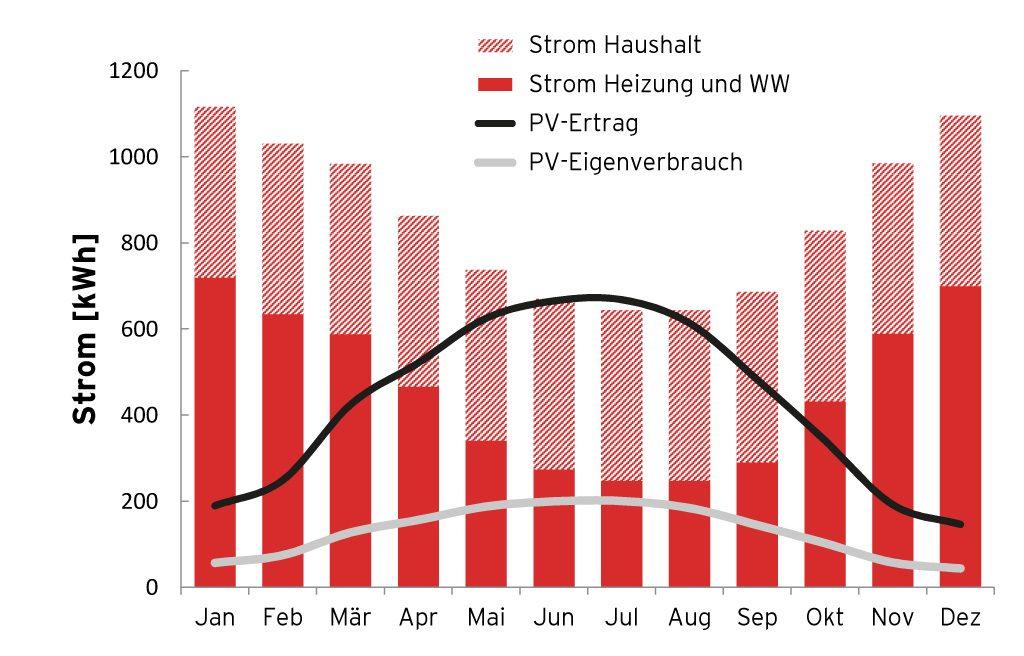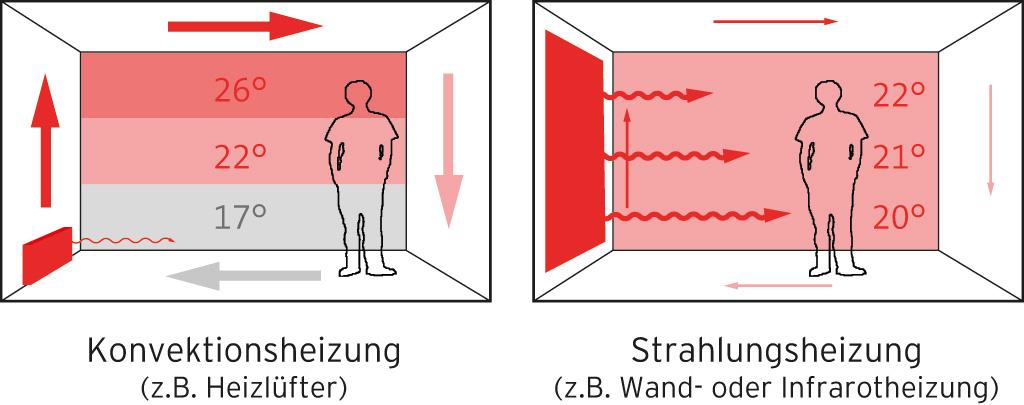Heat pumps are now the first choice in energy-saving new buildings because they use ambient heat and are very efficient. However, under certain circumstances, infrared heating can be a good alternative to a heat pump.
Infrared heating and heat pumps quickly explained
Heat pumps and infrared heating are both electrical heaters, but they work in fundamentally different ways. Infrared heaters are direct electrical heaters that are attached to the wall or ceiling as a flat panel and are powered by a socket. It is based on radiant heat and, unlike conventional heaters, does not heat the air in the room, but the walls, the floor and the objects. This creates a particularly pleasant room climate. Infrared heaters are quickly installed, inexpensive and durable.
A heat pump transports the ambient heat from the outside air, the groundwater or the ground into the house. A refrigerant in a pipe system serves as the means of transport. By compressing this refrigerant, the heat pump makes the ambient heat usable for heating. If heat is released, the agent is relaxed and the cycle starts again. The heat pump also needs electricity for this compression, but less than infrared heating. Because heat pumps are so efficient, they are often used for energy-saving houses.
High effort for the installation and maintenance of heat pumps
When comparing the efficiency, however, one quickly forgets that the installation, operation and maintenance of a heat pump involves a not inconsiderable amount of effort. A heat pump consists of many different components such as the heat generator, the heat source development (e.g. geothermal probe, geothermal collector, air heat exchanger, ice store), a buffer storage tank and heat transfer, such as underfloor heating or a heating circuit distributor. In addition, there are the control electronics, devices for measuring data acquisition and a building services room, which must be available. All of this has to be installed, monitored and maintained, which of course entails additional costs.

Infrared heating: Uncomplicated and hardly prone to failure
Infrared heating, on the other hand, can be installed in the desired room without much effort. The entire system consists only of the heating module and a thermostat. The acquisition costs are therefore significantly lower than with the heat pump, and the system is also much less prone to failure because there is little wear and tear. The CO2 footprint from production is also low: In terms of the so-called gray energy that is produced during the production, storage and transport of goods, infrared heating performs better than a heat pump thanks to its low material consumption.
Are infrared heaters energy guzzlers?
Infrared heaters used to be expensive energy guzzlers, which are only climate-friendly if they are operated with green electricity. In the meantime, however, the framework conditions have shifted in favor of infrared heating. This applies above all to new buildings, which are better insulated and therefore require significantly less heating energy. The share of renewables in the German electricity mix is also increasing from year to year. As a study by the University of Applied Sciences in Constance showed, there is nothing to be said against infrared heating in well-insulated buildings, provided that a photovoltaic system is also available.
The IR-Bau research project
In the IR-Bau project between 2017 and 2019, the Konstanz researchers examined the advantages and disadvantages of infrared heaters compared to heaters with heat pumps. To do this, they compared water-based underfloor heating, electric underfloor heating and infrared heating with one another. The goal was to determine the differences in power consumption in real operation, taking all components into account. The researchers also calculated the life cycle assessment and the life cycle costs over 50 years.
They carried out measurements in four identical rooms with the different types of heating. In addition, the four rooms were digitally reproduced as a simulation model so that external influences were eliminated. In addition, the researchers obtained data from practice in a Darmstadt apartment building with 40 residents, which has a 36 kWp PV system. There, the heating is provided by infrared heaters mounted on the ceilings, while the hot water is provided by continuous-flow heaters.
Infrared heating wins in small and well-insulated buildings
The result: infrared heating is particularly advantageous in rooms that are not in constant use. They are characterized by a fast response time. The study also showed that users find the heat from infrared heaters very comfortable and very easy to use. Infrared heaters are a good alternative to heat pumps, especially in small and well-insulated buildings. The prerequisite is that the building generates its own solar power via a sufficiently large PV system.
When looking at 50 years, infrared heating scores economically when manufacturing, maintenance and disposal costs are taken into account. Infrared heaters consume more electricity, but have lower operating costs, which in combination with a PV system are below a heat pump system.
The researchers define the application limit of infrared heaters for very well insulated residential buildings with an annual heating energy requirement of less than 30 kWh/m² with around 1,500 - 2,000 m² of heated living space. However, the exact value always depends on the respective framework conditions. The smaller and the better insulated a building is, the greater the economic and ecological advantages of infrared heating compared to a heat pump.
If you invest the lower acquisition costs of infrared heating in a photovoltaic system, you get a system that heats less efficiently but generates large amounts of renewable electricity. An infrared heater can use this electricity directly. The PV system should be dimensioned in such a way that, in conjunction with a control system optimized for self-consumption, the mains power consumption of a heat pump is achieved over the heating period, the researchers write in their conclusion. A disadvantage of this solution is, of course, that power generation and consumption do not always take place at the same time. This is where intelligent solutions for electricity storage and grid balancing will come into play in the future.
Follow-up project IR-Bau 2 is intended to clarify further questions
The IR-Bau 2 project has been running since the end of 2020 and is carrying out further studies to derive reliable planning recommendations. It is about the effects of the building size (absolute energy consumption) and the building typology (load profile) on the economic and ecological assessment. The researchers are carrying out metrological analyzes in several buildings. They also want to clarify how different infrared technologies and how they are installed in the room affect efficiency and comfort and what influence different control strategies have on self-consumption of PV electricity when heating.
Sources / Read moreWhat is the difference between easyTherm and a heat pump? | easy ThermEfficient heating: Infrared heating versus heat pump | SunthermWhy infrared heaters are more efficient than heat pumps | TGASupplementary studies on the potential of IR heating systems | HTGWPotential of infrared heating systems for high-efficiency residential buildings | HTGWpv magazine Podcast: Infrared heaters and photovoltaics - An alternative in new buildings? | pv magazineImage Credit: © Pixabay










Tips to do your electrical installa...
Companies in the Pinneberg district...
Maintal is becoming a smart city th...
New subway workshop and wash bay in...